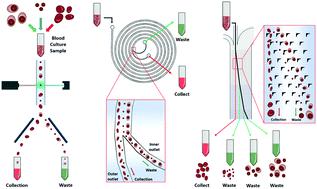Our official English website, www.x-mol.net, welcomes your feedback! (Note: you will need to create a separate account there.)
Microfluidic label-free bioprocessing of human reticulocytes from erythroid culture.
Lab on a Chip ( IF 6.1 ) Pub Date : 2020-08-14 , DOI: 10.1039/c9lc01128e Kerwin Kwek Zeming 1 , Yuko Sato , Lu Yin , Nai-Jia Huang , Lan Hiong Wong , Hooi Linn Loo , Ying Bena Lim , Chwee Teck Lim , Jianzhu Chen , Peter R Preiser , Jongyoon Han
Lab on a Chip ( IF 6.1 ) Pub Date : 2020-08-14 , DOI: 10.1039/c9lc01128e Kerwin Kwek Zeming 1 , Yuko Sato , Lu Yin , Nai-Jia Huang , Lan Hiong Wong , Hooi Linn Loo , Ying Bena Lim , Chwee Teck Lim , Jianzhu Chen , Peter R Preiser , Jongyoon Han
Affiliation

|
In vitro erythroid cultures from human hematopoietic stem cells produce immature red blood cells (RBCs) called reticulocytes, which are important for RBCs production, and are widely used in scientific studies of malaria pathology, hematological diseases and protein translation. However, in vitro reticulocyte cultures contain expelled cell nuclei and erythroblasts as undesirable by-products and current purification methods such as density gradient centrifugation and fluorescence-activated cell sorting (FACS) are not optimal for integrated bioprocessing and downstream therapeutic applications. Developments in Dean flow fractionation (DFF) and deterministic lateral displacement (DLD) microfluidic sorting methods are ideal alternatives due to label-free size sorting, throughput scalability and low manufacturing cost. DFF sorting of reticulocytes from whole erythroid culture showed a 2.4-fold increase in cell recovery compared to FACS albeit with a lower purity; DLD sorting showed comparable cell recovery and purity with FACS using an inverse-L pillar structure to emphasize size and deformability sorting of reticulocytes. The viability and functional assurance of purified reticulocytes showed conserved cell deformability and supported the propagation of malaria parasites. Collectively, our study on label-free RBCs isolation represents a significant technical advancement towards developing in vitro generated viable human RBCs, opening opportunities for close-loop cell manufacturing, downstream therapeutic and research purposes.
中文翻译:

来自类红细胞培养的人类网状细胞的无微流体无标签生物加工。
来自人类造血干细胞的体外类胡萝卜素培养物会产生称为网状细胞的未成熟红细胞(RBC),这对RBC的生产非常重要,并已广泛用于疟疾病理学,血液病和蛋白质翻译的科学研究。但是,体外网状细胞培养物含有排出的细胞核和成红细胞作为不希望的副产物,当前的纯化方法(例如密度梯度离心和荧光激活细胞分选(FACS))对于整合生物处理和下游治疗应用而言并非最佳选择。Dean流动分馏(DFF)和确定性横向位移(DLD)微流体分选方法的发展是无标签大小分选,吞吐量可扩展性和低制造成本的理想选择。来自全红系培养物的网状细胞的DFF分选显示,与FACS相比,细胞回收率提高了2.4倍,尽管纯度较低;DLD分选显示了与FACS相当的细胞回收率和纯度,使用逆L柱状结构强调了网织红细胞的大小和可变形性分选。纯化的网织红细胞的活力和功能保证显示出保守的细胞变形能力,并支持疟原虫的繁殖。总的来说,我们对无标签RBC分离的研究代表了在开发方面的重大技术进步体外产生的可行人类红细胞,为闭环细胞制造,下游治疗和研究目的提供了机会。
更新日期:2020-09-15
中文翻译:

来自类红细胞培养的人类网状细胞的无微流体无标签生物加工。
来自人类造血干细胞的体外类胡萝卜素培养物会产生称为网状细胞的未成熟红细胞(RBC),这对RBC的生产非常重要,并已广泛用于疟疾病理学,血液病和蛋白质翻译的科学研究。但是,体外网状细胞培养物含有排出的细胞核和成红细胞作为不希望的副产物,当前的纯化方法(例如密度梯度离心和荧光激活细胞分选(FACS))对于整合生物处理和下游治疗应用而言并非最佳选择。Dean流动分馏(DFF)和确定性横向位移(DLD)微流体分选方法的发展是无标签大小分选,吞吐量可扩展性和低制造成本的理想选择。来自全红系培养物的网状细胞的DFF分选显示,与FACS相比,细胞回收率提高了2.4倍,尽管纯度较低;DLD分选显示了与FACS相当的细胞回收率和纯度,使用逆L柱状结构强调了网织红细胞的大小和可变形性分选。纯化的网织红细胞的活力和功能保证显示出保守的细胞变形能力,并支持疟原虫的繁殖。总的来说,我们对无标签RBC分离的研究代表了在开发方面的重大技术进步体外产生的可行人类红细胞,为闭环细胞制造,下游治疗和研究目的提供了机会。


























 京公网安备 11010802027423号
京公网安备 11010802027423号